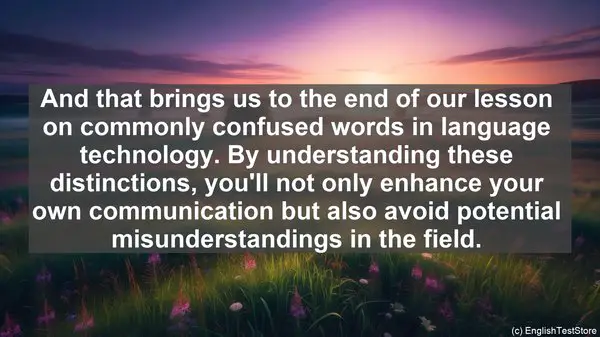Introduction: The Importance of Word Choice
Welcome to today’s lesson on commonly confused words in language technology. In the world of technology, precision is key. A slight misunderstanding can lead to significant errors. That’s why it’s crucial to have a firm grasp on the distinctions between similar-sounding words. Today, we’ll explore ten such pairs that often trip people up. Let’s get started!
1. Data vs. Datum
The word ‘data’ is commonly used to refer to a collection of information. However, when we’re talking about a single piece of information, the correct term is ‘datum.’ While ‘data’ is plural, ‘datum’ is its singular form. So, it’s essential to use ‘datum’ when referring to a single unit of information.
2. Algorithm vs. Algorithmic
An ‘algorithm’ is a step-by-step procedure for solving a problem. On the other hand, ‘algorithmic’ is an adjective that describes something related to algorithms. So, while we say ‘algorithm’ when referring to the procedure itself, we use ‘algorithmic’ to describe things that are based on or related to algorithms.
3. Syntax vs. Semantics
In the field of language technology, ‘syntax’ and ‘semantics’ are two crucial concepts. ‘Syntax’ refers to the structure and rules governing the arrangement of words and phrases in a language. On the other hand, ‘semantics’ deals with the meaning behind those words and phrases. So, while ‘syntax’ focuses on the form, ‘semantics’ is concerned with the content and interpretation.
4. Accuracy vs. Precision
When we talk about measurements or predictions, ‘accuracy’ and ‘precision’ are often used interchangeably. However, they have distinct meanings. ‘Accuracy’ refers to how close a measurement or prediction is to the true or expected value. ‘Precision,’ on the other hand, refers to the consistency and reproducibility of the measurement. So, while ‘accuracy’ is about correctness, ‘precision’ is about consistency.
5. Natural Language Processing vs. Natural Language Understanding
Both ‘natural language processing’ (NLP) and ‘natural language understanding’ (NLU) are essential in language technology. ‘NLP’ focuses on the interaction between computers and human language, enabling tasks like translation or sentiment analysis. ‘NLU,’ on the other hand, goes a step further, aiming to comprehend the meaning and context behind the language. So, while ‘NLP’ deals with processing, ‘NLU’ is about understanding.
6. Machine Learning vs. Deep Learning
In the realm of artificial intelligence, ‘machine learning’ (ML) and ‘deep learning’ (DL) are often mentioned. ‘Machine learning’ refers to the approach where algorithms learn from data and improve their performance over time. ‘Deep learning,’ on the other hand, is a subset of machine learning that focuses on neural networks, attempting to mimic the human brain’s structure and function. So, while ‘ML’ is a broader concept, ‘DL’ is a more specialized area within it.
7. Tokenization vs. Lemmatization
When it comes to text processing, ‘tokenization’ and ‘lemmatization’ are two fundamental techniques. ‘Tokenization’ involves breaking down a text into individual units, often words or sentences. ‘Lemmatization,’ on the other hand, aims to reduce words to their base or root form. So, while ‘tokenization’ focuses on segmentation, ‘lemmatization’ is about normalization.
8. Overfitting vs. Underfitting
In machine learning, finding the right balance is crucial. ‘Overfitting’ occurs when a model is overly complex, fitting the training data too closely. This can lead to poor generalization and performance on new, unseen data. ‘Underfitting,’ on the other hand, happens when a model is too simple, failing to capture the underlying patterns. So, while ‘overfitting’ is about excessive complexity, ‘underfitting’ is about insufficient complexity.

9. Preprocessing vs. Postprocessing
In the pipeline of language technology tasks, ‘preprocessing’ and ‘postprocessing’ are two critical stages. ‘Preprocessing’ involves cleaning and transforming the raw data, making it suitable for further analysis or modeling. ‘Postprocessing,’ on the other hand, deals with the output of a system, refining or enhancing it before it’s presented to the user. So, while ‘preprocessing’ is about preparing, ‘postprocessing’ is about refining.
10. Cloud Computing vs. Edge Computing
With the increasing demand for computational power, ‘cloud computing’ and ‘edge computing’ have emerged as two prominent paradigms. ‘Cloud computing’ refers to the practice of using remote servers, often via the internet, to store, manage, and process data. ‘Edge computing,’ on the other hand, aims to bring the computation closer to the data source, reducing latency and bandwidth requirements. So, while ‘cloud computing’ is about centralization, ‘edge computing’ is about decentralization.

